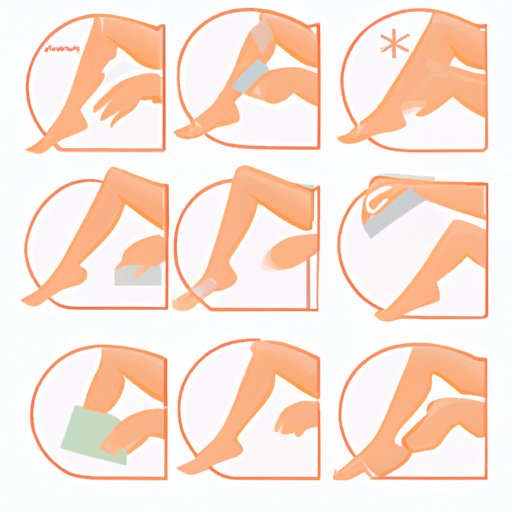
I. Introduction
Ingrown hairs are a common and irritating problem that occur when hair grows back into the skin, instead of out of it. They can happen anywhere on the body where hair grows, but are most common on areas that are shaved or waxed, such as the face, legs, underarms and bikini area. While ingrown hairs are not harmful, they can be unsightly, painful, and lead to infection if not properly treated.
In this article, we’ll explore tips and techniques for removing ingrown hairs safely and effectively.
II. Warm Compresses
A warm compress can help soften the skin, open up pores and release the hair that is trapped underneath. Here’s how to make one:
- Soak a clean washcloth in warm water.
- Wring out the excess water and press the washcloth onto the affected area for 10 to 15 minutes, re-wetting the cloth as necessary to keep it warm.
- Repeat several times a day until the hair is visible and can be removed with tweezers.
Using a warm compress before attempting to remove an ingrown hair can make the process less painful and reduce the risk of infection.
III. Gentle Exfoliation
Exfoliation can help remove dead skin cells that may be trapping the hair, allowing it to grow normally. However, it’s important to use gentle exfoliation techniques, as aggressive scrubbing can make the problem worse. Here are some recommended techniques:
- Use a gentle scrub, such as one made from sugar or salt, to massage the affected area in circular motions for a minute or two.
- Apply a chemical exfoliant, such as salicylic or glycolic acid, to the affected area using a cotton ball or pad, being careful to avoid any open wounds or broken skin.
- Rub the area with a clean, dry washcloth using gentle pressure to help smooth the skin and release the hair.
Exfoliation should be done just once or twice a week to avoid irritating the skin, and always followed by moisturizer to prevent dryness and irritation.
IV. Targeted Creams or Remedies
There are several creams and remedies available that can help remove ingrown hairs and prevent new ones from forming. Here’s an overview of the most common types:
- Topical antibiotics: These can be applied to the affected area to reduce inflammation and prevent infection.
- Retinoids: These are used to exfoliate the skin and prevent the buildup of dead skin cells that can lead to ingrown hairs.
- Tea tree oil: This essential oil has antiseptic and anti-inflammatory properties that can help reduce redness and irritation caused by ingrown hairs.
- Benzoyl peroxide: This can help reduce inflammation and kill bacteria that can lead to infection.
When using creams or remedies, be sure to follow the instructions carefully and avoid any products that contain alcohol, as this can dry out the skin and make the problem worse.
V. Proper Grooming Techniques
Ingrown hairs can be caused by improper grooming techniques, such as shaving too close or using a dull razor. Here are some dos and don’ts to keep in mind:
- Do use sharp razors and change them regularly to prevent pulling or tugging on the skin.
- Don’t shave too close to the skin or pull the skin taut, as this can increase the risk of ingrown hairs.
- Do shave in the direction that the hair is growing, rather than against it.
- Don’t shave dry skin – always use a shaving gel or cream to lubricate the skin and reduce friction.
- Do exfoliate regularly to keep the skin smooth and prevent dead skin cells from trapping hair.
- Don’t wear tight clothing that can trap hair against the skin, such as leggings or compression shorts.
- Do use a moisturizer to keep the skin hydrated and prevent irritation.
By following these tips, you can help prevent ingrown hairs from forming in the first place.
VI. Conclusion
Ingrown hairs can be both uncomfortable and unsightly, but there are simple steps you can take to safely and effectively remove them. By using warm compresses, gentle exfoliation, targeted creams and remedies, and proper grooming techniques, you can prevent ingrown hairs from forming and keep your skin smooth and healthy.
Remember to always be gentle when dealing with ingrown hairs, as aggressive techniques can cause further irritation and lead to infection. If you have a severe case of ingrown hairs or notice signs of infection, such as pus or redness, it’s best to consult with a healthcare professional for further treatment.





